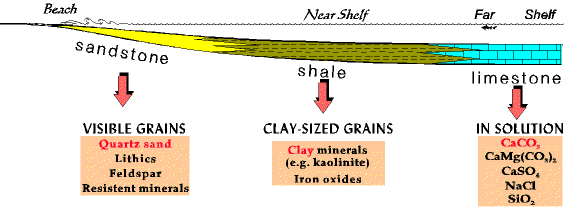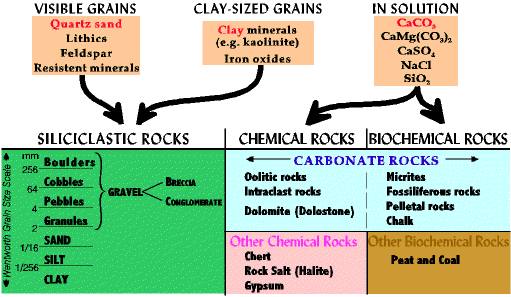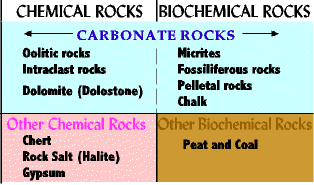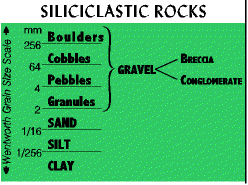
|
CLASSIFICATION SYSTEMS:
>> QFL Key >> QFL Ternary IDENTIFICATION KEYS:
|
How You Classify It,
Is How You Think About It
A Basic Sedimentary Rock Classification
A good classification is based on some theory that explains how the rocks form, and are related to each other. We want to group together rocks that form by similar processes. The most general theoretical model we have for sedimentary rocks is the simple ideal model. The basic classification is based on that model.The complication with sedimentary rocks is they form from such a diversity of processes that straight forward classifications are difficult. They are unlike igneous rocks where a relatively straight forward Texture and Composition classification leading directly to interpretation is possible.
For the basic sedimentary rock classification you can use the table at the top (go to enlarged clickable version), or use the key (also linked in the box above left), or go to the alphabetical listing to directly study individual sedimentary rocks. An explanation of the theory behind the basic classification is below.
More sophisticated classifications are described in other pages (Clastic {QFL key, or QFL ternary}, and Carbonate).
Reasoning Behind the Basic Classification
The simple ideal model for the evolution of sedimentary rocks says there are three end products, three attractors, that all sedimentary processes are working to reach - quartz sandstone, shale, and limestone. {html version of all illustrations on this page combined; pdf version for printing}
The three attractors in the simple ideal model are not isolated, however; each one stands for a class of weathering products. For example:
Quartz sandstone = all visible grains, including such ones as incompletely weathered feldspar from the granodiorite in the simple ideal model.
Shale = all clay sized grains (clay is a generic name; there are many kinds of clay minerals as well as other minerals that are clay sized)
Limestone = all dissolved minerals, including not only calcite CaCO3, but also halite (table salt; NaCl), and gypsum (CaSO4 . H2O) among others.
On the chart below we can see these additional weathering products.

| OBSERVE: A source of confusion is the switch from mineral names to rock names. Clay is a mineral that forms from the weathering of feldspars such as orthoclase. Clay is extremely fine grained; it is the mud on your shoes, or the mud (suspended clay) in a river or pond. When clay is deposited it becomes the rock shale Calcite (CaCO3) is a mineral with rhombohedral cleavage that reacts with dilute hydrochloric acid. As a sedimentary mineral it exists either as micrite (" lime mud", that is as fine grained as clay) or large pieces such as animal skeletons. These together form the rock limestone. Quartz sand is, or course, just quartz sand. It is released as grains from the parent rock by weathering, and after that is little changed. See the grains in this alkali granite. All but the quartz will weathering into something else. In addition, some mineral names also refer to the rock, so gypsum the mineral is also gypsum the rock. Sometimes we also make a distinction, such as dolomite the mineral and dolostone the rock, or halite the mineral and rock salt the rock. |
So far, so good. But now we have to do some mixing and splitting. Sedimentary rocks are generally divided into three great categories, siliciclastic (or simply, clastic) rocks, chemical rocks and biochemical rocks. Their relationships to the three divisions from the simple ideal model are shown in the figure below. Observe how visible grains and clay sized grains mix together to form clastic rocks, while minerals in solution split to form chemical and biochemical rocks.

(Silici)Clastic rocks are composed of weathering products that do not dissolved into water, have silica (SiO2) as one of their major components, and are transported either by rolling along the bottom, or in suspension. Because of this the VISIBLE GRAIN and CLAY SIZED GRAIN weathering products in the chart above tend to be mixed, and deposited together. So we group them together as SILICICLASTIC rocks. (Further explanation below).
Minerals IN SOLUTION on the other hand tend to be deposited together, and are not generally deposited in the presence of siliciclastic rocks. Indeed, these rocks are so different from clastic rocks that geologists often specialize in studying either one group or the other. Thus we split these out from clastics.
To deposit minerals that are in solution, they must some how come out of solution and this happens two ways. Either they precipitate directly from sea water (usually because it is evaporating and concentrating the salts) - CHEMICAL ROCKS.
Or " plants" and " animals" extract the dissolved minerals from the sea water to make skeletons, their skeletons eventually becoming part of the sediment as BIOCHEMICAL ROCKS. So, minerals in solution split into two categories.
Note that we still end up with a classification with three main categories, it is just a slightly different three categories than the simple ideal model.
CHEMICAL/BIOCHEMICAL ROCKS
 Chemical/biochemical rocks fall into several groups, depending on how they form.
Chemical/biochemical rocks fall into several groups, depending on how they form.CARBONATES: These are composed of the mineral calcite (CaCO3 - calcium carbonate), and are thus all known as carbonates. Note on the chart that there are many of these, that they form by both chemical and biochemical processes, and that they tend to be mixed together in various combinations in the rocks. They are extremely abundant and important.
OTHER CHEMICAL ROCKS: These rocks fall into two categories. Chert is a siliceous rock (composed of SiO2) that forms from the recrystalized skeletons of " animals " (single celled radiolarians, and glass sponges) or single celled " plants " (diatoms, silicoflagellates). And although the silica comes from skeletons to become chert it must be chemically recrystallized, thus putting it in the chemical category (but it is confusing).
Rock salt (halite; NaCl) and gypsum (CaSO4 . H2O) originally are dissolved in the sea water, thus making the sea salty. When sea water evaporates in a closed area, such as a lagoon, the salt concentration becomes very high, supersaturated, and precipitates out. The process is common in desert areas, with examples today in the Red Sea and Dead Sea in the Middle East, both highly saline.
OTHER BIOCHEMICAL ROCKS: Peat and coal because they come from plant remains are biochemical rocks, but unlike all the other chemical/biochemical rocks peat and coal always form in the presence of clastic rocks - sandstones and shales.
This discussionillustrates part of the difficulty of developing a completely consistent classification. Sedimentary rocks form in so many different ways, from so many different processes that coming up with one scheme that is inclusive and yet straight forward is not easy. There always seem to be exceptions to the rule that have to have to be explained individually.
(SILICI) CLASTIC ROCKS
 Clastic rocks (sandstones, shales, etc.) are classified on two criteria - texture (grain size), and composition (that is, QFL).
Clastic rocks (sandstones, shales, etc.) are classified on two criteria - texture (grain size), and composition (that is, QFL).Shale, of course, is both fine grained, and composed of clay, so the name "shale" incorporates both properties of texture and composition.
For the coarser sizes, where the mineral grains can be seen by eye or with a handlens, a complete name consists of two parts. For example, an " arkose sandstone " is a rock composed of sand sized particles, and a large percentage of those particles are composed of feldspar.
For this basic classification we are only concerned with particle size; composition will be saved for the QFL (quartz, feldspar, lithics) classification.
Clastic particles are divided into size categories based on the WENTWORTH SCALE. This scale has been in use for over a hundred years and is universally recognized. The middle size is 2 mm, the boundary between sand and gravel. Note that the size categories get geometrically larger, and smaller, from 2 mm. Sand, for example, ranges from 1/16 mm to 2 mm, while granules range from 2 mm to 4 mm, and pebbles from 4 mm to 64 mm. The reason for this is we want to group together particle sizes that can moved more or less together by running water.
The Wentworth scale is straight forward, and with a ruler for scale it is relatively easy to classify the rock. One simplification, and one complication, though. The simplification is, we generally group all the greater than sand sized particles into one category - gravel, unless there is a specific need to distinguish these grain sizes. The complication is, gravel is divided into whether the grains are angular (breccia), or rounded (conglomerate).
